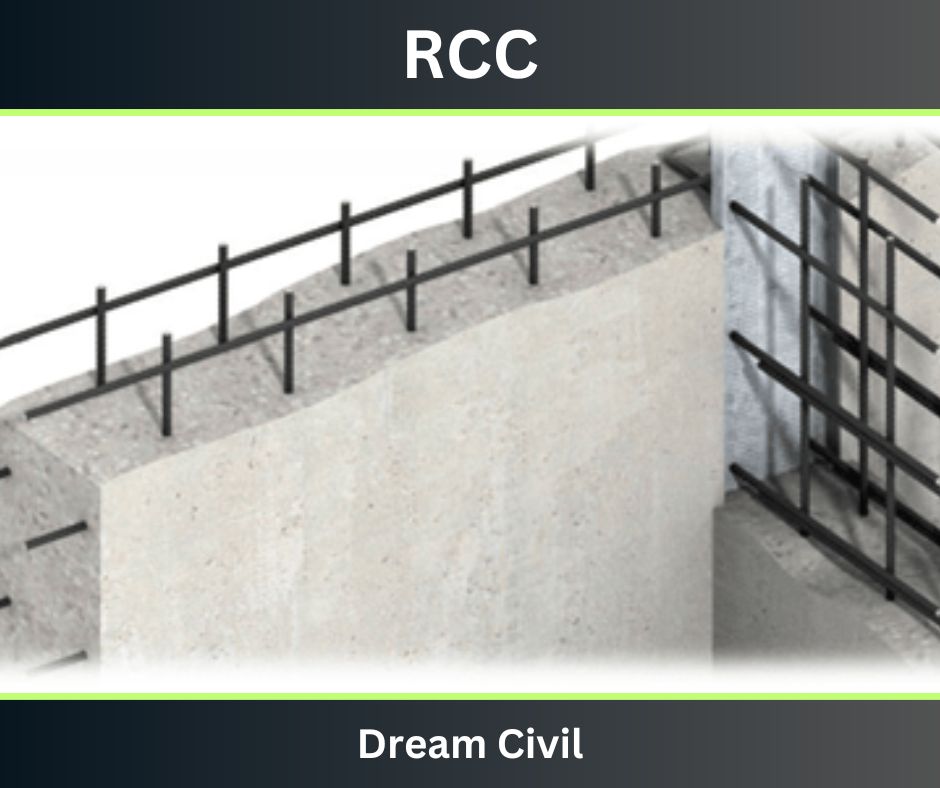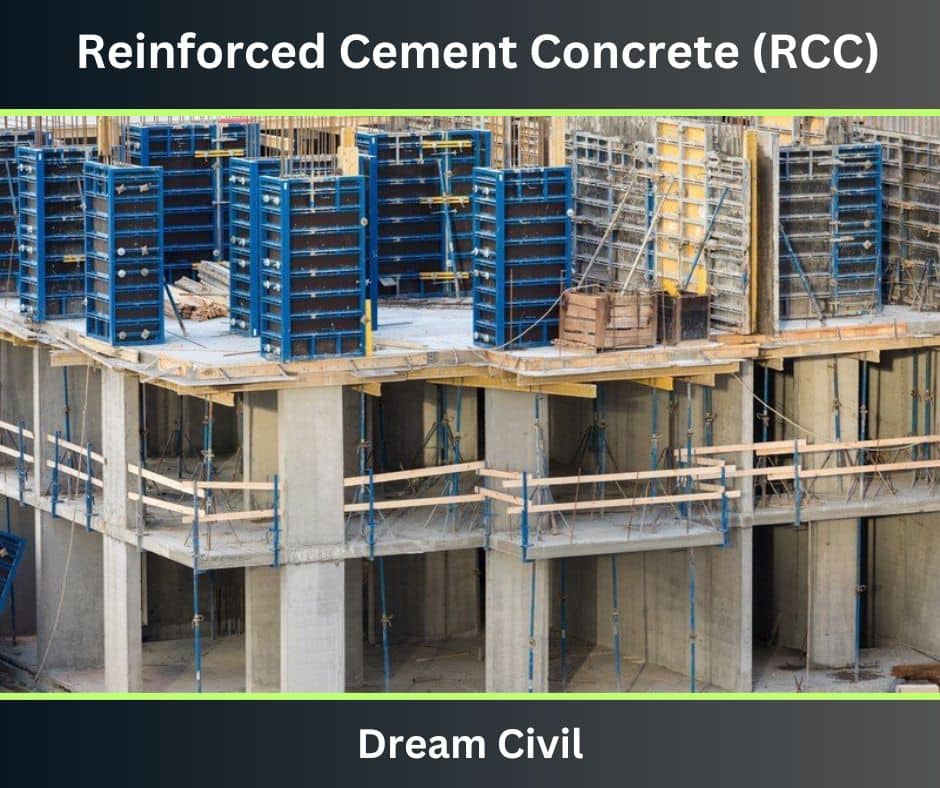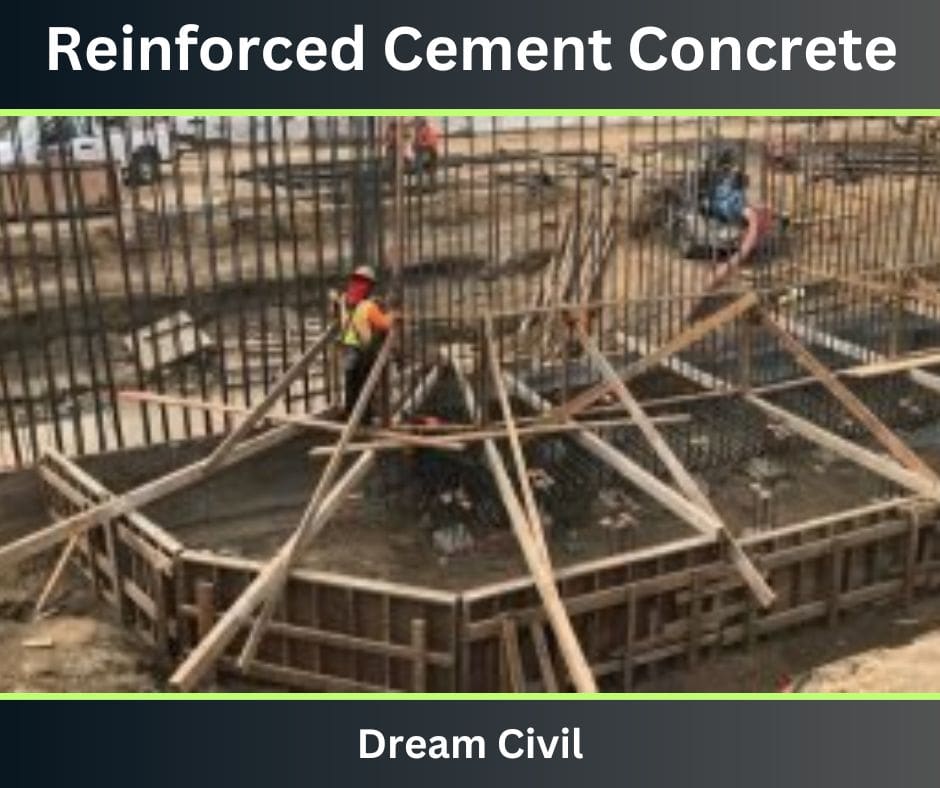Table of Contents
The cement concrete in which reinforcement is provided for taking tensile or excessive compressive and shear stresses is called Reinforced Cement Concrete. It can be abbreviated as RCC.

Some of the characteristics posses by good reinforcing materials are:
1. It should have tensile strength and a high modulus of elasticity.
2. It should have the same temperature coefficient of expansion and contraction as concrete so that thermal stresses do not develop.
3. It should be cheap and easily available.
4. It should be able to develop a perfect bond with concrete.
5. It should be able to resist very harmful effects, if any, produced by the concrete.
6. It should be easy to cut, bend or weld.
Almost all the above requirements are consummated by steel and thus it is commonly used as a reinforcing material.
In the past, cheaper materials like glass, bamboo, asbestos, etc. as reinforcing materials were used but due to some inherent defects in them, they could not claim a wider field of application.
a. The steel reinforcement to be used should be in the form of round bars 6 mm to 32 mm in diameter.
b. Expanded metal or steel fabric in the form of a mesh of steel rods, molded together, are also used as reinforcement in concrete walls, etc.
c. Flat bars are more useful in the case of tanks and pipes etc.
d. Usual proportions of ingredients in reinforced cement concrete are:
1 part Portland Cement:1 to 2 clean sand:2 to 4 parts shingle or crushed stone.

1. Properties of Reinforced Cement Concrete (RCC)
The combination of steel and concrete becomes practicable for the following three reasons:
1. The coefficient of linear expansion of concrete and steel is almost the same. Therefore, no internal stresses are set up within reinforced concrete due to the temperature change.
2. The coating of cement on the surface of steel bars protects them from corrosion and chemical effects.
3. The concrete while setting grips very fast on the surface of the steel bars. Therefore the concrete transmits the stresses which steel bars cannot resist.
| Read Also: Formwork, Types of Formwork |
2. Advantages of Reinforced Cement Concrete (RCC)
Reinforced cement concrete entails the following advantages:
1. It doesn’t rot or decay and is not attacked by termites.
2. It is fire-resisting.
3. It is economical in cost.
4. It is almost impermeable to moisture.
5. Its maintenance cost is negligible.
6. Its constituents are easily available.
7. It doesn’t develop cracks.
8. It can be easily molded to the required shape.
9. It is durable.
10. It provides monolite (without joint) construction of structural members.
11. It provides a good structural appearance.
12. The structural members of the desired strength can be made.
3. Disadvantages of Reinforced Cement Concrete (RCC)
The disadvantages of reinforced cement concrete are:
1. High initial cost.
2. Heavier than steel construction.
3. Skilled supervision and workmanship are required.
4. Involves additional cost of formwork.
| Read Also: 26 Types of Concrete |
4. Uses of Reinforced Cement Concrete (RCC)
RCC is commonly used for the construction of the following:
1. Slabs
2. Lintels
3. Beams
4. Columns and their footings
5. Raft or mat foundations
6. Precast or cast-in-situ concrete piles etc.

5. Basic Assumptions of Reinforced Cement Concrete (RCC)
Some assumptions that are made in the Reinforced cement concrete for design purposes:
1. Plain transverse section before bending remains plain after bending.
2. All tensile stresses are taken up by steel reinforcement only and the resistance of concrete to tension is nil.
3. Concrete is homogenous and elastic. It is also of uniform quality and strength. The stress, therefore, is proportional to strain. It also follows the stress diagram on the compression side which will be a triangle, the resultant compressive stress acting at the center of the triangle.
The bond between concrete and steel is perfect within certain limits and they act unitedly.
6. General Requirements of R.C.C. Design
The mix should be carefully designed so that the maximum compressive strength of the concrete is available and both steel and concrete are stressed to their maximum permissible stresses after taking into consideration all possible loads and various criteria of failure.

Some of the important design requirements are:
1. Main reinforcement should be adequate to resist direct tensile stresses.
2. Area of concrete should be sufficient to take up compressive stresses.
3. Sufficient bend should be developed between the joints of the rods.
4. Adequate provision should be made for shearing stresses.
7. Causes of Failure of Reinforced Cement Structures
The following are the causes of the failure of Reinforced Cement Structures:
1. Subjecting of the member to excessive tension, to exceed the permissible stress in steel.
2. When the loading is such that the compressive stress in concrete exceeds its safe permissible value.
3. Slipping off the steel bars from the concrete.
4. Subjecting of concrete to excessive shear.
5. Use of bad quality materials, shrinkage creep, or thermal effects.
5. References1. Content Filter & Authenticity Checking Team, Dream Civil International (Our team checks every content & detail to maintain quality.) |
Read Also: Concreting Under-Water

